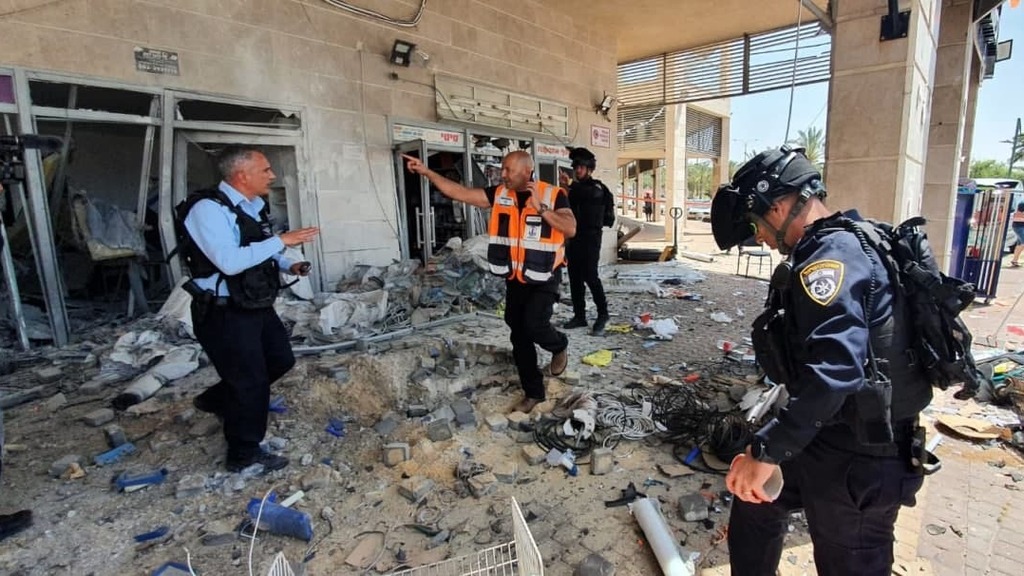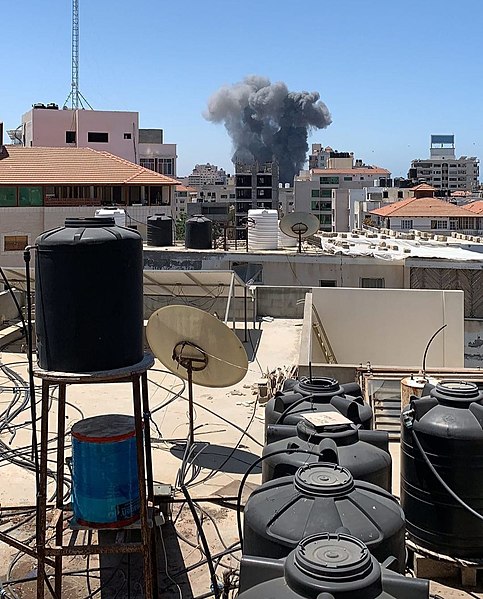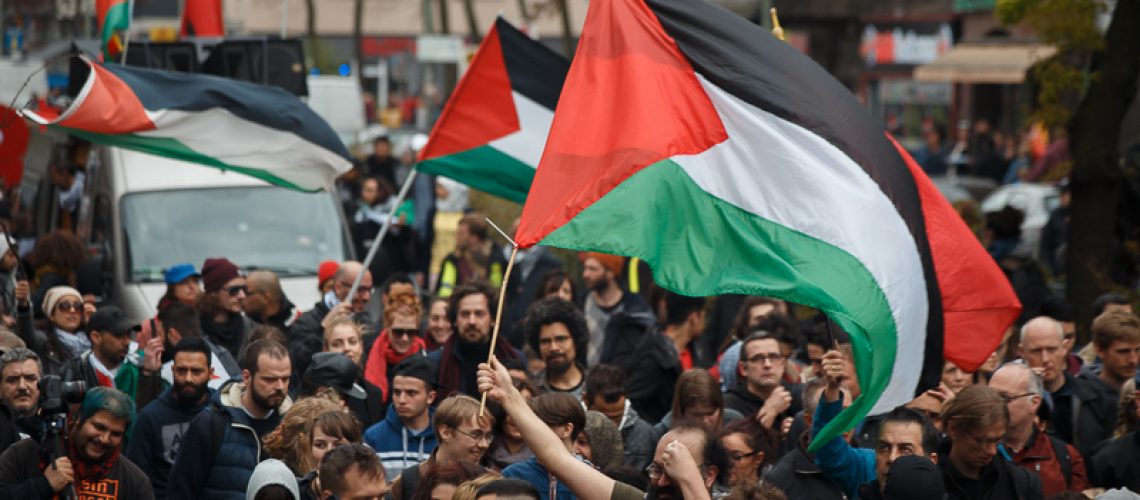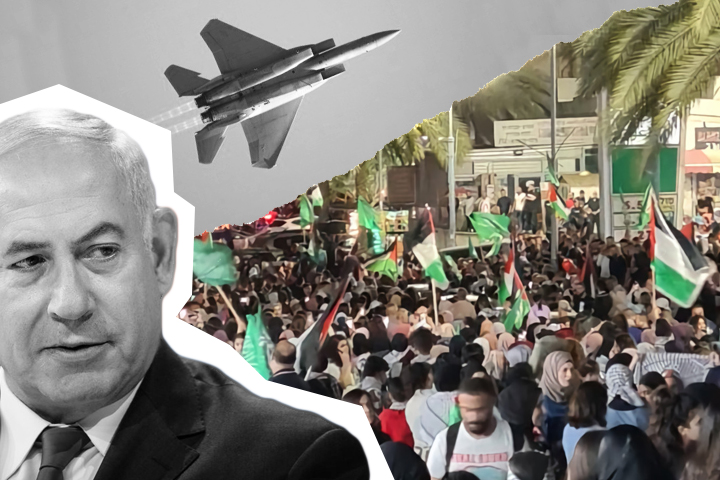After eleven days of the ruthless bombardment of Gaza – which has killed more than 240 Palestinians (almost half of whom were children and women) and left thousands severely injured – Israel has eventually agreed to a ceasefire. The bombardment caused the displacement of 75,000 people. Their homes have been destroyed and severe damage has been inflicted on essential infrastructure: schools, hospitals (including the only COVID-19 testing and vaccination centre), electricity and clean water supplies. The population of Gaza will pay a heavy price for many years to come for Israel’s attack.
The Egyptian regime of Al-Sisi, which for years enforced a blockade in collaboration with the Israeli state that has strangled the livelihoods of the people in Gaza, is claiming credit for brokering the ceasefire. Along with other reactionary Arab regimes that sided with and openly supported Israel only last year – the UAE, Saudi Arabia, etc. – they are trying to renew their pro-Palestinian credentials by announcing plans for aid and reconstruction, which they will use as leverage with Hamas or else will conveniently shelve at the first opportunity.
All the reactionary Arab regimes, from Morocco to Saudi Arabia, have been caught off guard by the rising militancy of the Palestinian struggle. In particular, they have been caught off guard by how it has connected with the revolutionary sentiment of the mass of the working class and youth throughout the Middle East. The legitimacy of these regimes has been enormously undermined by these events, adding combustible material to the revolutionary crises that are being prepared in those countries.
The so-called ‘progressive’ Biden administration has yet again shown its true colours. It immediately supported “Israel’s right to self-defence” in the course of the bombing campaign, while quietly pressuring Netanyahu behind the scenes to agree to a ceasefire once Israel had caused enough destruction. The hypocrisy of US imperialism’s pretence of neutrality is completely exposed. The United States subsidises the Israeli military to the tune of billions of dollars every year, whilst exporting huge amounts of military hardware to Israel. No one can have any doubt about where US imperialism stands and, as always, it is on the side of the oppressors.
We have to be clear: Biden and US imperialism are not concerned to the slightest degree about the suffering of the Palestinian people, nor with their legitimate demands. What concerns them is that Netanyahu’s adventures may provoke a further destabilisation of US-friendly Arab regimes in the area: Egypt, Jordan, the Gulf monarchies and beyond. What US imperialism is really afraid of is the resurgence of the Arab Revolution on an even higher level than ten years ago.
The Palestinian youth have been leading a militant mass struggle against Israel’s ruthless war on their brothers and sisters in Gaza. It is significant to note that the struggle started within the 1948 borders of Israel and it was led and organised by committees, networks and organisations which were outside of the official Palestinian “leadership”. This revealed a deep mistrust of Fatah and the Palestinian National Authority, as well as Hamas. Notably, we have seen the organisation of mass self-defence against the violent anti-Palestinian pogrom activities of far-right mobs and Zionist settlers, attacking Palestinians and their homes and shops within 1948 Israel, which were carried out with the acquiescence or open support of the Israeli security forces.
These mobilisations have cut across existing divisions, unifying the Palestinian struggle against the occupation, discrimination and oppression in Gaza, the West Bank, East Jerusalem, the Palestinian refugee camps and, most notably, inside the 1948 Israeli green line. This struggle is resonating with the working class and youth of the whole world, and has inspired an international wave of solidarity that is growing on a global scale.
The Palestinians in struggle greeted the ceasefire with defiant demonstrations, joy and relief, but also with an awareness that nothing fundamental has been resolved. They have shown a determination and willingness to fight on.
As Marxists, we enthusiastically salute the emergence of a unified Palestinian mass struggle as the most important conquest of these past weeks.
Netanyahu’s cynical manoeuvres exposed
Netanyahu and the Israeli Defense Force are claiming they have achieved their military aims. However, these claims are hollow and unconvincing. Contrary to what Netanyahu wishes everyone to believe, it is clear that nothing has been resolved from the point of view of the Israeli ruling class.
The ceasefire is just a tactical manoeuvre, but the strategy of the Zionist right-wing of displacing the Palestinian population, effectively stealing their homes and livelihoods, and progressively curtailing their rights, continues.
The programme of the Zionist settlers was summed up by Arieh King, deputy mayor of Jerusalem: “I want Jerusalem to be secured forever as a Jewish city, and the only way to protect it from radical Muslims is by being more than them,” he said. “The heart of the Jewish nation is the Temple Mount - and the layers protecting the Mount will be the Jewish presence around it.”
Israel’s – or rather Netanyahu’s – aim was never that of destroying Hamas, but rather of containing it. Netanyahu, and his right-wing allies, need Hamas.
 Netanyahu, and his right-wing allies, need Hamas and never aimed to destroy it / Image: Israel Ministry of Foreign Affairs, Flickr
Netanyahu, and his right-wing allies, need Hamas and never aimed to destroy it / Image: Israel Ministry of Foreign Affairs, Flickr
From a military point of view, Hamas’s rockets, though improved in number and accuracy, are no match for the might of Israel’s firepower, and 90% of them are intercepted by its Iron Dome defences. However, the sound of air raid sirens across Israel is very useful to Netanyahu from a political point of view. It has the effect of rallying Israeli Jews around the state and government “in the face of the foreign enemy”. This was the cynical calculation by Netanyahu when he escalated the provocations at the al-Aqsa Mosque during Ramadan at a time when a coalition government excluding him was about to be formed.
Furthermore, Israel has every interest in playing off Hamas’s domination in Gaza against the Fatah-led Palestinian Authority of Abbas, ensuring the division and fragmentation of the so-called Palestinian leadership. Lastly, Israel does not want to destroy Hamas because it is the only existing force capable of controlling – suppressing and policing – the Palestinian population in Gaza. In recent years, Netanyahu even went to the extreme of stepping in – behind the scenes – to put pressure on the Qatari regime to guarantee a financial lifeline to Hamas.
Netanyahu’s main aim was to cynically use the war-like escalation that he deliberately provoked, in order to save himself from the pressure mounting against him, and consolidate his unstable position at the helm of a crumbling government. Netanyahu had no better means of achieving this than by playing the tried-and-tested game of confrontation with Hamas, rallying support around himself, and posturing in his favourite role as Israel’s strong man in the face of a national emergency. Except this time round, Netanyahu’s gamble doesn’t seem to have paid off.
Why was there no ground invasion of Gaza?
Netanyahu had assured Israeli Jews that the Palestinian people had been neutralised, divided, defeated and demoralised. He assured them that the neighbouring Arab regimes were willing to accept and recognise the existence of Israel despite the persisting oppression of the Palestinian people and the occupation of their land. He assured them that, under his iron fist, Israel had become a safe place for the Jews. All these assurances are being exposed as lies in the eyes of the Israeli population.
Those, inside and outside Israel, who supported the bombing of Gaza as a means of “protecting Israeli lives from the threat of Hamas” are now asking themselves: how can the Israeli government claim that Hamas’ capability to assemble and launch rockets has been destroyed by these so-called “surgical” bombings? One of the main lessons of previous Israeli attacks against Gaza – hammered home by Israeli mass media – has precisely been that without a ground invasion, bombardment alone is bound to be ineffective – even assuming Israel has access to the most accurate intelligence on what to target. This was made clear in October 2020 by Avi Kochavi, Israel’s Chief of Staff, as Haaretz reported: “It is impossible to bring the achievement over our enemies without the [ground] maneuver, without a massive entry of forces”.
 During the Gaza bombing, at various moments the IDF announced it was considering invading Gaza / Image: Osps7
During the Gaza bombing, at various moments the IDF announced it was considering invading Gaza / Image: Osps7
The conclusion that ordinary Israelis are drawing from this is naturally one of scepticism. Yet again there will be another uneasy truce – until the next inevitable escalation. Capitalism and Zionism, regardless of the figure of Netanyahu, are not creating conditions for a dignified life or a safe haven for the Jews in Israel. All they can guarantee is the continuation of the present nightmare and deeper oppression and hatred along national and religious lines.
During the Gaza bombing, at various moments the IDF announced it was considering invading Gaza – as they did in 2014 (killing 2,400 Palestinians). But the threatened ground invasion never materialised. Why?
Haaretz pointed out how Netanyahu’s own precarious position was a key factor:
“As for Prime Minister Benjamin Netanyahu, at the moment he has a minimum of public credit to launch controversial moves. It’s hard to enter into a dangerous military incursion that will generate heavy casualties when half the population doesn’t believe a word you say and suspects, with some degree of justice, that you deliberately heated up the tension in Jerusalem for political and personal reasons.”
The Palestinian Israelis at the centre of the struggle
The immediate aftermath of the ceasefire confirms, however, that something has shifted in the situation – and quite dramatically. Far from being tamed and demoralised by Israel’s asymmetrical display of brute force, the Palestinian mass struggle, led by the youth, has conquered centre stage.
The Palestinian general strike of 18 May, along with the growing defiance and determination shown throughout the past period by the Palestinian youth within Israel and in the occupied territories, has shown what a powerful impact the movement of the working class can have on events.
For the first time in decades, the general strike showed clearly – in practice – what we have been arguing for a long time: that a unified mass struggle against the occupation and the oppression of the Palestinian people throughout the territory of historical Palestine was necessary and would represent a breakthrough. Not only was it possible – it has become a reality.
This is the result of years of accumulated resentment caused by the increased pressure on the Palestinians by the discriminatory and oppressive policies of the Israeli state. Over the past few years, we have witnessed a rapid acceleration of the reactionary Zionist project, designed to marginalise and discriminate against the Palestinian minority within Israel, alongside the growth of the settler movement in East Jerusalem and the West Bank, now numbering more than 650,000 illegal Jewish settlers.
Netanyahu proclaimed Jerusalem as the undivided capital of Israel, supported by Trump’s announcement that he was moving the US embassy from Tel Aviv to Jerusalem. This was backed up by US recognition of Israeli claims over the occupied Golan Heights. Meanwhile, we’ve seen the intensification of the Israeli state-backed settlements in the West Bank and East Jerusalem, up to the point of Israel threatening the unilateral annexation of parts of the colonised West Bank. The approval of the racist Jewish Nation State Law shattered the residual identification of the vast majority of Israeli Palestinians with the Israeli state, and provoked the open revolt and alienation of the most loyalist and conservative layers of the Palestinian population, notably the Druze.
This removed any illusions that Israel would ever allow a viable, independent Palestinian state. Any pretence of bilateral negotiation was swept to one side. It also meant that while the Palestinians in Gaza, the West Bank and East Jerusalem were subject to a blatant regime of occupation, within Israel the Palestinian minority was relegated to the position of second-class citizens.
The mass movement against the eviction of Palestinians in Sheikh Jarrah and the violence unleashed by the Israeli state against Palestinian worshippers in Al-Aqsa at the height of Ramadan marked a turning point in the consciousness of the Palestinians.
The bombing of Gaza then became the focal point, unifying the Palestinian struggle inside and outside of Palestine, joining it together with a broad international solidarity movement that mobilised hundreds of thousands of people.
Impact of the 18 May Palestinian general strike
Appeals for a general strike were already circulating on social media well before it was formally adopted by the High Follow-Up Committee, the united leadership of the ‘48 Palestinian population (those living within Israel). The main motorforce organising the strike on 18 May was the network of self-organised committees and youth groups that were at the heart of the protests until then. These self-organised committees sprang up in spite of the passivity of the so-called traditional leadership and in many instances have openly challenged it.
Mondoweiss published an interesting report by one of these activists in Haifa, revealing the real relationship between the official leadership of the movement and the activists on the ground:
“The activists are used to distrusting the leadership of the Follow-Up Committee, and some thought that a one-day general strike was not enough. But, soon, in the spirit of unity and empowerment that enabled the current uprising, all energies were united for the success of the strike.”
The call connected with the existing mood of mass defiance and escalated into a struggle against the bombing of Gaza, against the occupation, for dignity, equality, in defence of the elementary right of the Palestinians to defend their livelihoods, and against the Israeli state’s violence and oppression.
The general strike was an extraordinary display of militancy. Despite the repressive measures and threats of retaliation announced by Israeli companies and authorities against Palestinian workers, striking without legal cover from the Israeli trade unions, the strike had a visible impact.
The Israeli Builders’ Association admitted that only 150 out of 65,000 Palestinian building workers showed up to work, completely paralysing the building industry. The strike also affected transport, deliveries, cleaning, and healthcare within Israel, and it was felt in all sectors where there is a larger presence of Palestinian workforce.
The announcement of the strike was met with heavy media hostility. However, the language of the class struggle can break through and be understood by the rest of the Israeli working class, even at a stage when most of the Jewish Israeli workers are not supporting the Palestinian struggle, but are responding to what they perceive as a threat to their safety, thus backing the Israeli state.
 The Palestinian movement is part of the international revolutionary movement against capitalist exploitation and imperialist oppression / Image: Nowadays
The Palestinian movement is part of the international revolutionary movement against capitalist exploitation and imperialist oppression / Image: Nowadays
A comment reported by Haaretz from one Israeli crane worker is symptomatic of the mood. Observing the deserted building sites on the day of the general strike he said: “If we would all fight that way for workers’ rights maybe we would achieve something.” Regardless of the opinion this worker had of the Palestinian struggle, it is important to highlight that the strike posed in his mind, as well as in the minds of many other workers, the question of what could be achieved by a united, collective action of the working class.
Imperialist “peace” - the continuation of war by other means
The struggle of the Palestinian people against oppression constantly faces the danger of being cut across by the appeals of the Israeli ruling class to the Jewish Israeli population to rally around the state against external threats. It is vital for the Palestinian liberation movement that as part of the general struggle for liberation, tactics and forms of struggle are also developed aimed at consciously breaking down support for the Israeli state along class lines, of widening the class divide within the Jewish population itself. In order to do so, the most conscious and consistently revolutionary layers of the movement cannot confine themselves to purely democratic demands. These demands play a vital role in the struggle but, in themselves, they cannot resolve it. The socialist solution must be boldly posed.
In these past weeks, we have witnessed small joint Jewish-Arab demonstrations, where Jewish grassroots organisations have defied the general mood of hostility and have openly come out in support of the struggle against the Gaza bombing. These demonstrations are relatively small, a few thousands at most, but are important from a symptomatic point of view. As Marxists we welcome such movements and see it as our task to struggle to break the national and religious divisions fomented by the ruling class, along class lines.
Now that the bombing of Gaza has been suspended, the imperialist “peace” will be a continuation of war by other means. The Israeli regime will try to rein in the forces that have escaped its control. The policy of gradually curtailing Palestinian rights and responding to any protests with harsh repressive measures will continue. This week, hundreds more Palestinians have been arrested in Israel. The policy of evictions continues, with a renewed push to remove Palestinian families from the Batn al-Hawa area of Silwan in occupied East Jerusalem. The recent general strike and mass protests are an important development in showing how to confront this, and how the reactionary Israeli state can be countered and exposed.
The Palestinian movement is part of the international revolutionary movement against capitalist exploitation and imperialist oppression. It is clear that the struggle for the liberation of Palestinians is not confined within the borders of historic Palestine. It is linked to the struggle against the reactionary regimes in the Middle East, and their backers in Washington.
One after another, the present reactionary regimes in the Middle East will be shaken to their foundations by widespread revolutionary movements. As the Egyptian revolutionary movement of 2011, which overthrew the Mubarak regime, and the 2013 revolutionary upheaval against the Morsi government show: it is not enough to topple reactionary regimes if capitalism is not overthrown and if the working class does not seize power.
The struggle in Israel and Palestine can only be resolved on a socialist basis, as part of the revolutionary transformation of the whole Middle East. It is on the basis of this perspective that the revolutionary Palestinian youth and all those Jewish Israelis who are prepared to challenge the oppressive Zionist state must approach their struggle.
The revolutionary movement of the masses in historic Palestine is connecting up with the general revolutionary process against imperialist oppression and capitalism that is taking place across the whole of the Middle East. In the next period, we will see wave upon wave of powerful movements of the working class and the youth that will attempt to overthrow one oppressive regime after another in the region. It is in the context of this perspective that the Marxists are putting forward the programme of one Federal Socialist State of Israel/Palestine as part of a Socialist Federation of the Middle East, where oppression can be ended by revolutionary means and all peoples, including the Jews and the Palestinians, and all the other nationalities in the region, will have the right to decide on their own destinies, and find a common path to prosperity.

